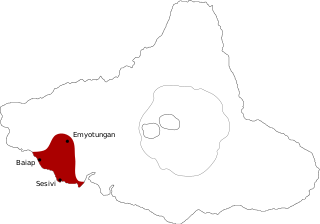
Fijian is an Austronesian language of the Malayo-Polynesian family spoken by some 350,000–450,000 ethnic Fijians as a native language. The 2013 Constitution established Fijian as an official language of Fiji, along with English and Fiji Hindi and there is discussion about establishing it as the "national language". Fijian is a VOS language.
Taba is a Malayo-Polynesian language of the South Halmahera–West New Guinea group. It is spoken mostly on the islands of Makian, Kayoa and southern Halmahera in North Maluku province of Indonesia by about 20,000 people.
The Nafsan language, also known as South Efate or Erakor, is a Southern Oceanic language spoken on the island of Efate in central Vanuatu. As of 2005, there are approximately 6,000 speakers who live in coastal villages from Pango to Eton. The language's grammar has been studied by Nick Thieberger, who has produced a book of stories and a dictionary of the language.
Máku, also spelled Mako, and in the language itself Jukude, is an unclassified language and likely language isolate once spoken on the Brazil–Venezuela border in Roraima along the upper Uraricoera and lower Auari rivers, west of Boa Vista, by the Jukudeitse. 300 years ago, the Jukude territory was between the Padamo and Cunucunuma rivers to the southwest.
Southern Athabascan is a subfamily of Athabaskan languages spoken in the North American Southwest. Refer to Southern Athabascan languages for the main article.

East Ambae is an Oceanic language spoken on Ambae, Vanuatu. The data in this article will concern itself with the Lolovoli dialect of the North-East Ambae language.
Yabem, or Jabêm, is an Austronesian language of Papua New Guinea.
Ughele is an Oceanic language spoken by about 1200 people on Rendova Island, located in the Western Province of the Solomon Islands.
Abui is a non-Austronesian language of the Alor Archipelago. It is spoken in the central part of Alor Island in Eastern Indonesia, East Nusa Tenggara (NTT) province by the Abui people. The native name in the Takalelang dialect is Abui tanga which literally translates as 'mountain language'.
Paamese, or Paama, is the language of the island of Paama in Northern Vanuatu. There is no indigenous term for the language; however linguists have adopted the term Paamese to refer to it. Both a grammar and a dictionary of Paamese have been produced by Terry Crowley.
Adang is a Papuan language spoken on the island of Alor in Indonesia. The language is agglutinative. The Hamap dialect is sometimes treated as a separate language; on the other hand, Kabola, which is sociolinguistically distinct, is sometimes included. Adang, Hamap and Kabola are considered a dialect chain. Adang is endangered as fewer speakers raise their children in Adang, instead opting for Indonesian.
Xârâcùù, or Kanala, is an Oceanic language spoken in New Caledonia. It has about 5,000 speakers. Xârâcùù is most commonly spoken in the south Central area of New Caledonia in and around the city of Canala and the municipalities of Canala, Thio, and Boulouparis.
Mavea is an Oceanic language spoken on Mavea Island in Vanuatu, off the eastern coast of Espiritu Santo. It belongs to the North–Central Vanuatu linkage of Southern Oceanic. The total population of the island is approximately 172, with only 34 fluent speakers of the Mavea language reported in 2008.
Tiri, or Mea, is an Oceanic language of New Caledonia.
Vamale (Pamale) is a Kanak language of northern New Caledonia. The Hmwaeke dialect, spoken in Tiéta, is fusing with Haveke and nearly extinct. Vamale is nowadays spoken in Tiendanite, We Hava, Téganpaïk and Tiouandé. It was spoken in the Pamale valley and its tributaries Vawe and Usa until the colonial war of 1917, when its speakers were displaced.
Vera'a, also known as Vatrata, is an Oceanic language spoken on the western coast of Vanua Lava Island, in the Banks Islands of northern Vanuatu.
Merei or Malmariv is an Oceanic language spoken in north central Espiritu Santo Island in Vanuatu.
Neve’ei, also known as Vinmavis, is an Oceanic language of central Malekula, Vanuatu. There are around 500 primary speakers of Neve’ei and about 750 speakers in total.

Daakaka is a native language of Ambrym, Vanuatu. It is spoken by about one thousand speakers in the south-western corner of the island.
Longgu (Logu) is a Southeast Solomonic language of Guadalcanal, but originally from Malaita.



